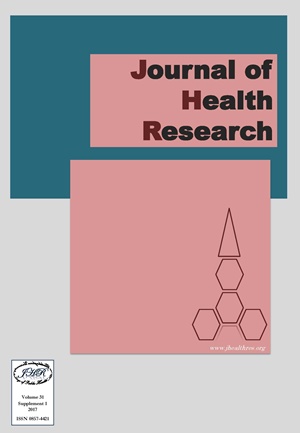Chemical Fertilizer Use and Acute Health Effects among Chili Farmers in Ubon Ratchathani Province, Thailand
Keywords:
Chemical fertilizers, Chili farmers, Health effects, Occupational exposureAbstract
Background: Chemical fertilizer use has increased globally over the past decades in agricultural countries such as Thailand. Currently, there is limited information regarding health effects related to chemical fertilizer exposure in Thailand. This study aimed to describe patterns of fertilizer use and to determine the prevalence of and factors associated with acute health effects related to chemical fertilizer exposure among chili farmers.
Methods: A cross-sectional descriptive study was conducted in Hua Ruea sub-district, Muang district, Ubon Ratchathani province in April 2016. Seventy-six chili farmers, directly contacting with chemical fertilizers, participated in the study. Face to face interviews were performed to gather information e.g. participant characteristics, frequency and kinds of fertilizer use, behaviors regarding chemical fertilizer use i.e. the use of personal protective equipment and hand hygiene, symptoms experienced while working with chemical fertilizers. Descriptive statistics were used to describe information. Chi-square test, Fisher’s exact test, independent t-test, or Mann-Whitney test were used to compare differences of participant characteristics between a group with and without acute health effects. Binary logistic regression analysis was used to explore factors associated with having health effects.
Results: All chili farmers used both chemical and organic fertilizers in chili farms. Most of them used chemical fertilizers 1-3 times monthly (80.3%). NPK fertilizer (formula 15-15-15) and urea fertilizer (formula 46-0-0) were commonly used. Improper behaviors regarding chemical fertilizer use were found e.g. handling chemical fertilizers with bare hands, and no personal protective equipment. About 26.3% of them reported having some symptoms within 48 hours while working with chemical fertilizers. Most common symptoms were coughing or sneezing (15.8%) and skin irritation or itching (14.5%). Using chemical fertilizers more than 3 times per month (OR adjust = 5.04, 95% CI: 1.04-24.56), alcohol consumption (OR adjust = 4.12, 95% CI: 1.24-13.67), and smoking habits (OR adjust = 4.30, 95% CI: 1.18-15.67) were the risk factors of having health effects related to chemical fertilizer exposure.
Conclusion: Chili farmers regularly used a variety of chemical fertilizers linked to increased risks of chemical fertilizer exposure. The prevalence of acute health effects related to chemical fertilizer exposure in chili farmers was relatively low. This study suggested that chili farmers should be more concerned about the safe use of chemical fertilizers to prevent health risks of chemical fertilizer exposure. Additionally, further investigate acute and long-term health effects of chemical fertilizer exposure are desirable.







